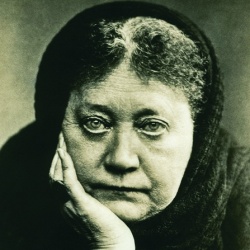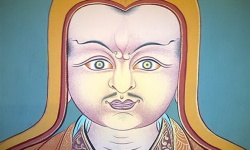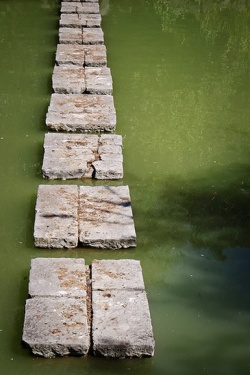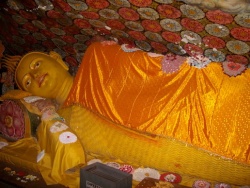Gendun Chopel
Amdo Gendun Chopel (a mdo dge 'dun chos 'phel, 1903-1951) was born in April or May 1903, somewhere near the Blue Kokonor Lake, to the north of Amdo, as his parents, Alak Gyelpo (a lags rgyal po) and Padma Kyi (pad+ma skyid), were returning from a pilgrimage to Central Tibet. This was just before Colonel Younghusband rode across the southern Himalayan border, on July 18, 1903, forcing Tibet into the modern world, and precipitating the process that would culminate in the first fully fledged Chinese invasion and occupation of the Land of Snows, in 1951. Gendun Chopel was to die on August eighth in that year, just a couple of weeks after the first soldiers of the Chinese Peoples' Liberation Army marched around the Barkor in the heart of the holy city of Lhasa. Thus his life spans with heroic precision, the most crucial period of recent Tibetan history.
Gendun Chopel spent the first ten years of his life in the hermitage of the celebrated ninteenth century yogin-poet, Zhabkar Tsokdruk Rangdrol's (zhabs dkar tshogs drug rang grol, 1781-1851), at Yama Tashikhyil (g.ya' ma bkra shis 'khyil), in the heart of the Ngakmang (sngags mang) community of Rebkong (re skong). His father was holder of one of the two main extant Ngakmang lineages, being third or fourth in line from the founder, Rigdzin Pelden Tashi (rig 'dzin dpal ldan bkra shis, 1688-1742). Like Pelden Tashi, Gendun Chopel was born in troubled times, and he too navigated between the Nyingma and Gelukpa traditions, maintaining a strong non-sectarian view throughout his life.
In 1912, the year his father died, Gendun Chopel was recognized as being a special child, by Terton Sogyal Lerab Lingpa (gter ston bsod rgyal las rab gling pa, 1856-1926), and by the third Dodrupchen Rinpoche, Jigme Tenpai Nyima (rdo grub chen 03 'jigs med bstan pa'i nyi ma, 1865-1926). Indeed, already before his birth it had been ‘predicted' that he was the incarnation of the former abbot of Dorje Drak, one of the principal Nyingmapa monasteries in Central Tibet. However, from the start, his parents had not been in favor of this role for their son, and he remained in Rebkong, continuing his studies in grammar and poetics, Sanskrit, Indian and Chinese astrology and art, before being sent off at the age of thirteen to the neighboring Gelukpa ‘hermitage-monastery' of Ditsa (dhi tsha / lde tsha / ldi tsha dgon), high on a lofty crest to the north of the great Machu River (rma chu; the Yellow River). The monastery had recently earned fame as an excellent monastic college thanks to the new curriculum set up by the Fourth Amdo Zhamar Gendun Tendzin Gyatso (a mdo zhwa dmar 04 dge 'dun bstan 'dzin rgya mtsho, 1852-1912), a learned geshe (dge bshes) who been one of the Thirteenth Dalai Lama's teachers in dialectics, before returning to Amdo to set up his new monastic college. It was he who gave Gendun Chopel his religious name during his getshul (dge tshul), or novice, ordination.
At Ditsa, Gendun Chopel learned the basics of logic and debate and earned a nickname that was to stick with him for the rest of his life, Ditsa Kambo (rdi tsha skam po), or “Skinny Ditsa.” During five years of study of the fundamental Buddhist texts, he made several return visits to his home in Yama Tashikhyil, as well as to the Nyingmapa practice center at Tso (gtsos), where he went through intensive training in the Longchen Nyingthig (klong chen snying thig) preliminaries, including the tsalung trulkhor (rtsa rlung 'khrul 'khor) at the feet of Kagya Terton (bka' rgya gter ston), a Ngakmang yogin who was well-known for his non-sectarian views. On his return to Yama Tashikhyil, after completing the trulkhor training, ‘Prince' Gurung, holder of the other major Ngakmang lineage, and a close friend of his father's, exclaimed how excellent it was to practice the yogas at a young age.
In 1920, at the age of eighteen, Skinny Ditsa entered the Gelukpa monastic university of Labrang Tashi Kyil (bla brang bkra shis 'khyil), launching himself into six years of brilliant studies, and gaining a reputation as an unbeatable and original dialectician. He also learnt the rudiments of English and clock mechanics from the local American missionary, Marion Griebenow, or Sherab Dampel (shes rab dam 'phel) as he was called, whose excellent knowledge of Tibetan allowed him to discuss the finer points of Christian and Buddhist doctrine with the learned monks from Labrang.
Following a few scandals in the debating arena, coupled with his new-fangled ‘invention' of mechanical birds and boats, Gendun Chopel began to feel the pressure of Gelukpa orthodoxy and the need to stretch his wings. At the age of twenty-five, he joined a caravan bound for Lhasa, travelling for three months on foot. At Nagchu (nag chu), just north of Lhasa, the entire company of two or three hundred were held up for one month before being allowed to finally reach the holy city. Once there, Gendun Chopel entered the Gomang college at Drepung Monastery ('bras spung sgo mang), to study at the feet of one of the most distinguished Gelukpa scholars of his day, Geshe Sherab Gyatso (dge bshes shes rab rgya mtsho, 1884-1968), who had also left Labrang for Tibet, thanks to an invitation sent by the Thirteenth Dalai Lama Tubten Gyatso (ta la'i bla ma 13 thub bstan rgya mtsho, 1876-1933).
Theirs was a close and fiery relationship, with Sherab Gyatso following the prevailing Gelukpa orthodoxy, while Gendun Chopel was opening up new horizons and neglecting his studies to a certain degree. The provisions his mother had given him were soon used up, and he earned his living through painting. With his natural skill as an artist he was soon in great demand among the Lhasa nobility, especially for his life-like portraits, and tigers ‘so real they might eat you up.'
Geshe Sherab, on the other hand, was in a privileged position. Apart from his teaching activities in Drepung, he accumulated the roles of ‘debating assistant' to the Thirteenth Dalai Lama, director of the new Lhasa edition of the Tibetan Kanjur in 108 volumes, and tutor to several young men from the noble families. Thus he maintained a residence in the holy city, where he had installed one of the rare private radios, and would often listen in to get the latest news on the progress of Mao Zedong. Thus, in spite of his orthodox religious point of view, Geshe Sherab was something of a rarity amongst the high level ecclesiastics, in that he was well aware of events in the outside world and deeply concerned for the future of Tibet. He had a wide circle of contacts, friends and disciples, and when Gendun Chopel was in Lhasa, on a painting job, he would often drop by to get the latest news coming in from near and far.
In the spring of 1934, at Geshe Sherab's place, Gendun Chopel met Rahul Sankrityayan, a sanyasin, or Hindi renunciate-turned Buddhist scholar. He was an adventurer, a prolific writer and member of the Indian Communist Party, and founder member of the Indian Peasants' Union. Rahul was on his second visit to Tibet, in search of ancient Sanskrit manuscripts. Appreciating Gendun Chopel's learning, Rahul invited him to join his entourage, promising to take the young Tibetan scholar back down to visit the Buddhist holy sites in India. Thus a couple of months later, they set off in search of the precious pelm-leaf manuscripts, hidden away in the thousand-year old libraries of the Land of Snows.
Their friendship and collaboration led to twelve years of exile for Gendun Chopel. Originally he had not intended to stay away for so long, but once India, his insatiable curiosity led him on to study Sanskrit and improve his English, and to make a thorough investigation of Buddhist archeological sites. He took a serious interest in the multiple writing systems of India, and became familiar with the Theravadin Vinaya, as well as Indian popular customs, with the movement for Indian independence, and with Gandhi's khadi ‘home-spun' economy. Rahul introduced him to the Mahabodhi Society and the Shri Rama Krishna Vedanta Ashram, in Darjeeling. Gendun Chopel began to publish articles questioning traditional Tibetan views on history, world geography, and the origin of Tibetan writing. He wrote bitingly satirical poetry aimed at his compatriots, with quite some self-mockery thrown in as well. He studied Sanskrit with Indian pandits, and met several Western Tibetologists, becoming the first Tibetan scholar to study the ancient historical manuscripts from the Tibetan Empire (7th-9th century) found in the Central Asian oasis of Dunhuang, just three decades previously. He consulted with a Chinese researcher in Kalimpong, and translated parts of the Tang Annals into Tibetan, as a source of comparison. Theos Bernard of Columbia University, New York, invited him to the United States, but unfortunately the outbreak of the Second World War prevented him from going. He had intended to present the Land of Snows to the West, and clear up a number of fallacies on the magic and mystery of Tibet.
In India Gendun Chopel abandoned his monastic vows and popular social norms, leading the life of a holy madman. He composed his own commentary on the Art of Love, based on several classical Sanskrit sources, as well as his own experience. He also smoked heavily and drank, and wrote a long sad poem of exile. A few letters show that he was hesitating about returning, not to Central Tibet, but to his homeland in Amdo, where he had been invited by the 5th Jamyang Sheba Lobzang Jamyang Yeshe Tendzin Gyeltsen ('jam dbyangs bzhad pa 05 blo bzang 'jam dbyangs ye shes bstan pa'i rgyal mtshan), the head lama of Labrang, to help set up a modern schooling system.
Instead of returning to Amdo Gendun Chopel stayed on, exploring the length and breadth of the Indian sub-continent, from Swat in the extreme north-west, to Sri Lanka in the extreme south, living frugally, from day to day, sometimes wailing about his poverty, sometimes getting paid small sums of money by foreign scholars, and even once begging for a few rupees from a friendly missionary.
By the late 1930s and early 1940s, Gendun Chopel had a well-established reputation as a scholar, and after spending some time exploring Sri Lanka, he went to live for two years with the family of the Russian painter and explorer Nicolas Roerich (1874-1947) at their avant-garde Urusvati Institute in Kulu–Manali. There he assisted Nicolas' son George (1902 – 1960) with the English translation of the Blue Annals (deb ther sngon po) by Go Lotsāwa Zhonnu Pel ('gos lo tsa ba gzhon nu dpal, 1392-1481), one of the major Tibetan historical works, reading through and discussing the entire text with him. The result of their fruitful collaboration was a book of some 1275 pages, published in Calcutta, in 1949.
The Roerichs were ardent supporters of the peoples of Central Asia, being especially enthused by the Mongol-Tibetan Buddhist alliance. The father, Nicolas, was a famous artist who had designed the costumes and scenery for the first performance of Igor Stravinsky's seminal production, The Rights of Spring, staged in Paris in 1913, with Nijinsky as choreographer, and Diaghalev as impresario. In Kulu, the close-knit family held open house to Mongolian pilgrims and travelers. They had a large library and what must have been one of the first modern ecological research stations, experimenting with Himalayan materia medica, intending to combine traditional medicinal practice with modern Western science. During his stay in Kulu, Gendun Chopel discovered a number of new ideas and authors, including, Sufi mysticism, Russian orthodox Christianity, Schopenhauer, Kant and Marx, as well as the modernist symbolism of Nicolas Roerich's art.
All the way through his time abroad Gendun Chopel was a familiar figure in Kalimpong, where he went to escape the hot summers, and to work with Tharchin Babu in his Mirror Printing Press, helping with the Tibetan language Mirror newspaper, where several of his articles were published. In the 1940s, Kalimpong – the gateway between India and Tibet – became a hotspot for exiled political figures from the Land of Snows. Gendun Chopel fell in with radical Tibetans who were working for the future of what they called the ‘Real Tibet', and who were advocating immediate reforms, or even the overthrow of the Ganden Podrang (dga' ldan pho brang) government of the Dalai Lamas. These included Baba Puntsok Wangyal ('ba' ba phun tshogs dbang rgyal, b. 1922), Changlochen Kung Sonam Gyelpo (lcang lo can kung bsod nams rgyal po, b. 1898), and Rabga Pomdatsang (rab dga' spom mda' tshang), to name but the most well-known. Gendun Chopel joined them, becoming a mentor and spiritual guide to Rabga Pomdatsang, who was an admirer of Sun Yatsen and founder of the ill-fated Tibet Improvement Party.
During his travels around the sub-continent, the Amdo scholar had been assembling materials for an encyclopedia of Indian classical civilization and popular culture, and had become skilled in drawing maps. It was decided that he should return to Tibet, via Bhutan and Mon Tawang, to explore the territory along the famous MacMahon Line that had been the object of dispute between Tibet, India and Republican China, at the Simla conference in 1913-1914. He was to draw a map showing the historic boundaries of Tibet in that region. But this was a fatal move, for the map was intended by Pomdatsang to be used by the Guomindang for their designs on Tibet, and this contributed no doubt to the later accusations against Gendun Chopel, saying he was a ‘communist' spy.
Once back in Lhasa, Gendun Chopel was courted by all and sundry for his knowledge of the outside world, and for his new ideas with regard to Tibet. The progressive families amongst the nobility supported him and provided for his frugal needs. He was consulted on every subject, and began to teach grammar and art to a number of notable individuals, including two Nyingma lamas, Lachung Apo (lha chung a pho, 1905-1975) and Dawa Zangpo (zla ba bzang po, 1916-1958). At the same time he began to put together his research notes gathered over twelve years of study and exploration, and to write a political history of Tibet, his unfinished White Annals (deb ther dkar po). His celebrity piqued the interest of the British representative in Lhasa, Hugh Richardson (1905–2000), who began to take even greater notice of the person he named “Chopel-la.” Richardson had both a professional and personal interest in the Amdo scholar, for he knew – more or less – about the political maneuverings of the progressive Tibetans in Kalimpong, and had also developed, in the latter years of his sojourn in Lhasa, a strong interest in ancient Tibetan history. He knew of Chopel-la's excellent reputation among the Western Tibetologists with regard to this new and exciting area of study.
Unfortunately, in the unstable political climate of Lhasa in the late 1940s, just at the time of the violent confrontation between the two regents Reting (rwa gdreng) and Tagdrak (stag brag) in 1947, Gendun Chopel became a target for ecclesiastical extremists and conservative nobles. He was arrested, whipped, and falsely accused of producing fake banknotes, of being a communist spy, and of being paid by the Guomindang, among other things. He was thrown into prison, first at Nangtseshak (snang rtse shag), the city court of Lhasa and the central jail, and then at Shol (zhol) at the foot of the Potala Palace. His precious research materials written during twelve years of exile in India were stolen and never returned.
After his release a couple of years later, either in 1949 or 1950, he re-established himself as a scholar. He was given a flat on the Barkor, just south of the Jokhang, a yearly stipend, with the order to resume work on the White Annals, which he did not do. There he lived with a woman from Chamdo and began to teach once again. He also started to drink much more heavily than usual, although it is said that he remained lucid and unaffected by the alcohol. The teachings he gave to his Nyingma student, Nyarong Dawa Zangpo, on Nāgārjuna's Madhyamaka philosophy, became the basis for Gendun Chopel's great philosophical work, the Adornment for Nāgārjuna's Thought (klu sgrub dgong rgyan). He warned him of the reaction this treatise might provoke in ecclesiastical circles, once published, and indeed, it is this text that is remembered by the orthodox Gelukpa, as well as by the Nyingmapa, as the key point in a violent contention that broke out with regard to Gendun Chopel and his place in the Tibetan philosophical tradition. When the first woodblock print was published on handmade Tibetan paper and sold around the Barkor in Lhasa, it immediately caused an uproar. Not long afterwards, His Holiness Dudjom Rinpoche Jikdrel Yeshe Dorje (bdud 'joms 'jigs bral ye shes rdo rje, 1904-1988) provided funds for a reprint to be made in Kalimpong, in traditional format, but using steel movable type, on green industrial paper. This edition matched the reputation of the author, being both inside and outside of tradition.
In September 1951, Gendun Chopel watched through heavy eyelids from the rooftop of his apartment on the Barkor, as the advance guard of Chinese soldiers from the People's Liberation Army walked the streets of Lhasa, and he knew that his hopes and those of the progressive Tibetan intelligentsia had been dashed to the ground. He said of himself, ‘a priceless lapis lazuli vase has been dashed against a stone.' He and all his dreams for a future Tibet, integrated into the modern world yet retaining its own cultural identity and history, were broken. The next month Gendun Chopel developed severe edema, possibly a result of cirrhosis of the liver. He died in the middle of October, 1951.
Sources
Stoddard, Heather. 1985. Le mendiant de l'Amdo. Paris: Societe d'ethnographie.
Mengele, Irmgaard. 1999. dGe-'dun-chos-'phel: A Biography of the 20th Century Tibetan Scholar. Dharamsala: Library of Tibetan Works and Archives.
K. Dondrub. 1978. “Gedun Chophel: The Man Behind the Legend.” Tibetan Review 21, no. 10, pp. 10-18.
Lopez, Donald. 2006. The Madman's Middle Way. Chicago: University of Chicago Press.
Lopez, Donald, 2009. In the Forest of Faded Wisdom: 104 Poems by Gendun Chopel. Chicago: University of Chicago Press.
Heather Stoddard
Paris, October 26, 2009




